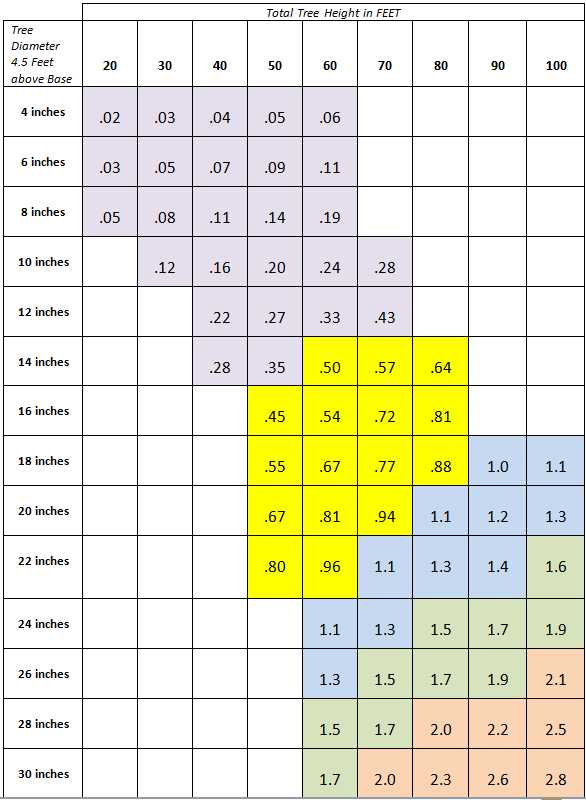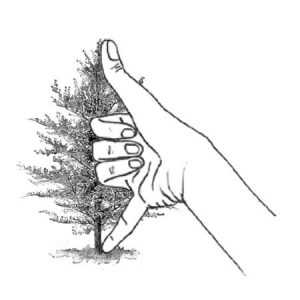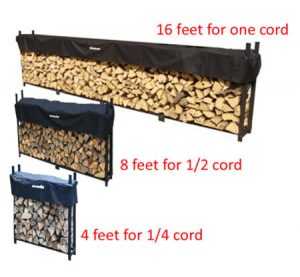Old-timers had rules of thumb: experienced-based guides about how many cords of firewood a tree would yield. One of those is that a tree that is 18 inches in diameter at the base and four times the height of a man will yield a half-cord of firewood.
Various types of trees, and even trees of similar species, that meet the 18-inch base distance across and about 24 feet tall criteria will yield somewhat various amounts of split firewood. Nevertheless, this How Much Firewood per Tree guideline has been a useful piece of folk knowledge that has withstood the test of time.
Throughout the years, people, particularly landowners who wanted to grow their firewood or grow firewood available to be sale wanted more precise ways to calculate the How Much Firewood Per Tree in Cords information. Accordingly, the general guideline was replaced by the accompanying table from which one can decide how much firewood per tree, as estimated in cords, is available.
The Volume of Firewood Per Tree Chart as Measured in Cords
To use the table, you will need two measurements per tree: height and diameter at chest height, that is, 4.5 feet up from ground level. Note that this diameter measurement is different from the diameter at the base of the tree used in the rule of thumb.

The purple squares indicate less than a half cord of firewood.
The yellow squares indicate a yield of from half a cord up to just less than one cord.
The blue squares yield equal to or greater than one full cord but less than 1.5 cords.
The green squares indicate a yield of 1.5 cords up to just less than two cords of firewood.
The orange squares indicate two cords or more of firewood yield.
Ways to Measure the Height of the Tree
To use the How Much Firewood per Tree diagram above, you must have the tree’s height or possibly a good estimate. To measure the height of a tree, we offer two methods. One is the respected “guestimate” that requires no special equipment. The other is the modern variant, using your cell phone or tablet.
Instructions to Measure the Height of the Tree Using Folk Knowledge
- Select a tree to measure for height.
- Close one eye. Point your opposite hand at the tree, keeping your elbow rigid. Now make a fist and point your thumb upward and your little finger toward the ground. Spread your thumb and little finger as far apart as possible.
- Line up your open eye with the highest point of your extending arm.
- Holding this arm and eye in this position, walk either toward the tree or away from the tree until the top of your thumb lines up with the top of the tree and the bottom of your little finger lines up with the base of the tree. Mark the spot you are standing.
- Measure from the spot you were standing to the base of the tree. (If you know the length of your stride, you can count your steps to the tree. Then multiply the number of steps times the length of your stride to get the distance to the tree.)
- Gap the measured distance by 3 for a decent estimate of the tree’s height.

Why it works: The range from your thumb to your little finger is 1/3 of the length of your arm.
Measuring the Height of the Tree Using your Smartphone
Many apps are available in the phone market for Android or IOS to measure the tree’s height. These apps use the camera feature of your Smartphone or tablet to measure the height of a tree using the camera’s height from the ground and the tilt of the phone. Before using, you have to set the app to know the height from the ground at which you typically hold the Smartphone when taking photos (generally, eye level is your height minus 4 inches.)
Storing the Cords of Firewood
If you store 14 inch long pieces of firewood on a log rack 4 feet tall, you will require the accompanying space to store your cords of firewood.

Along these lines, to decide the number of trees of what size you will require, first know how much firewood you will need and how much is a cord of wood. Then you will want to know how to stack it correctly.
This table is just a rough guestimate for the trunk size of the tree. It doesn’t mention the tally of the branches. Different species (such as oak vs birch) will produce a variable bonu$ $upply of useable firewood as well. Happy Harvesting!
Yes Gary, I totally agree with your point. It provides a rough estimate just to give a basic idea. But we will try to cover your concern in our upcoming blogs. Pls stay connected and feel free to share more thoughts.